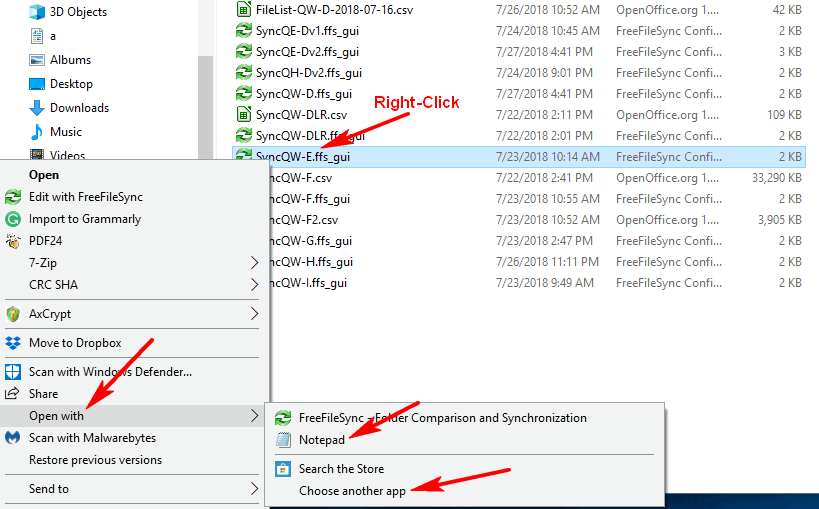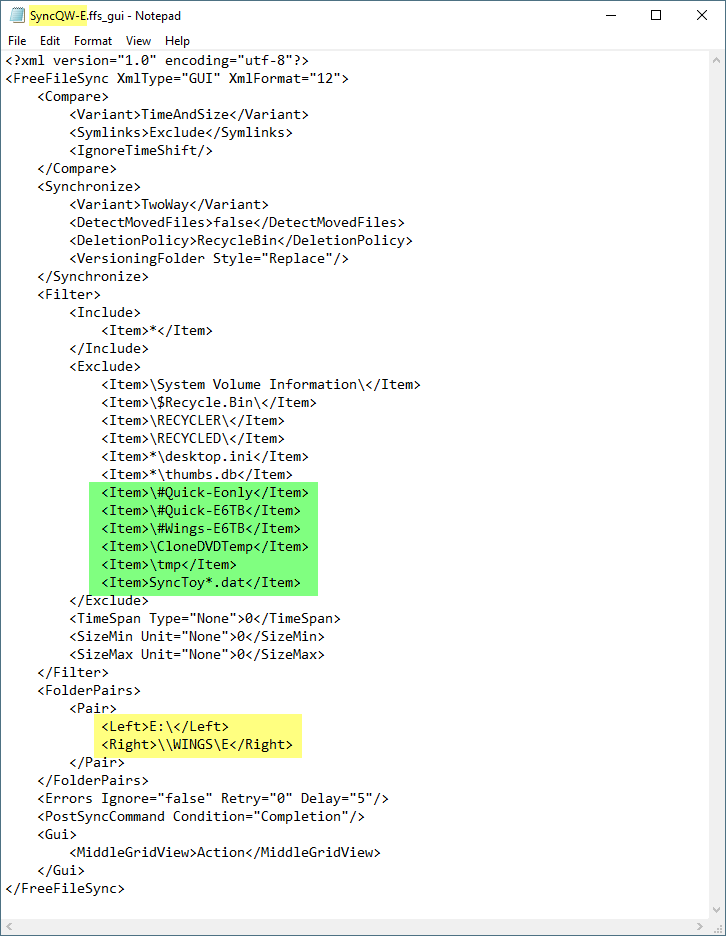
Why I like FreeFileSync
and How I Use It
by Wren McMains
(12/01/2018)
History
Before exploring why I like FreeFileSync I thought I might share a little of my history and my interest in User Interfaces. I've been involved in computers for well over 55 years. First teaching and doing research at MIT for many years, then with a large consulting company with a variety of commercial clients, and finally working at two companies which manufactured computers before I went to work for myself so I could afford Ivy League tuitions.
I was involved in operating system, compiler and database development. Not just using databases, but the actual development of the database engine. The companies that built their own computers had to also create all the create all their own system software (compilers, drivers, backup, printing programs, etc). I soon found myself in charge of all that development (and even the hardware engineering when our Hardware VP got cancer). Because I joined the second company when it was small (the first had 600 programmers when I joined) I got to know many of the early customers and because of my interest in User Interfaces enjoyed seeing how the products were used and learning how they could be improved.
Since Backup Tools were so important to these customers (and I was responsible for them) I took special interest in all the ways users could accidentally loose all their data, including multiple backup copies. It was amazing the inventive ways they could find to do it. I remember one who lost all their data, but had 5 days worth of complete backups. It wasn't until the wiped out 3 of those trying to restore them that they called for help.
Because I was working with companies that manufactured specialized computers when PCs first became available I didn't have any of my own originally. I had much bigger and more powerful ones to play with. It wasn't until I starting working for myself that I got my first PCs, first a desktop and an early laptop for travel, and then new and better desktops with an older one serving as backup for the newer one. Now I had the problem how to keep current copies of at least what I was actively working with on the various machines. At the time there were no useful tools to do this and certainly no networks for PCs. Copying everything to 5.25 and 3.5 inch floppies was the only choice. Then I discovered a product called the Brooklyn Bridge (and yes I bought it). I was actually a multi-end cable that plugged into serial or parallel port and software to go with it show what was new or updated on the machine at each end of the cable. Then networks came along. I stopped using the cable, but the software worked across the network. Remember this all started long before windows, so it wasn't a graphical interface, just an amazingly good user interface using a character display in a DOS window.
Then along came the 32-bit operating system and the Brooklyn Bridge software no longer worked. I couldn't find anything close, so just wrote my own. I continued to use it until Charlie introduced me to SyncToy about 12 years ago. SyncToy has NOT been updated in 9 years ... this is good and bad. What's good is no bugs are being introduced and you don't have to learn new interfaces every few years. What's bad is that new features I would like have never been added and some things are more painful than they should be.
I got thinking about one feature I've wished it had for years (saving the list of files backed up and/or about to be backed up) and wondered if there were any programs out there that might have that feature. (Over the years a couple of programs have been recommended to me, but they weren't free and didn't really seem any better than SyncToy. I would have bought them if they had great new features, but why should I pay for and have to learn to use a program no better than SyncToy?)
A quick Google search lead to an article on six free Sync programs. I must admit I never looked beyond their first choice, since it had exactly what I was looking for and more.
Summary of my Favorite FreeFileSync features
- Ability to save the list of what is about to be backed up. Sometimes either SyncToy or FFS shows you're about to backup or delete thousands of files when you know the number should be a few hundred at the most. With SyncToy I had to scroll down the list of thousands and remember a couple of folders that were causing problems. I would try and fix those and would then have to run the SyncToy Preview again, repeating this process over and over.
With FFS the list can be saved as a CSV file so it can be imported into your favorite spreadsheet program where it can be sorted and manipulated and multiple problems fixed before running the Compare again.
- SyncSettings for each backup are saved as XML files which can easily be edited with you favorite text editor.
This means you can create new folder pairs by just copying one of these files and making simple edits. To make the same backup to another drive or machine with SyncToy you had to create a new folder pair and potentially spend 15 minutes specifying all the sub-folders.
- Faster than SyncToy. The Preview is 50 to 300% faster in normal operation. I doubt that actaully copying the files is much faster although in some cases it feels like it might be a bit faster (especaially the first time which in some cases is MUCH faster).
But what's more important to anyone with several very large drives, after you create a new folder pair the first time you run the Preview often takes 45 minutes or more even if the contents are exactly the same (as happens when you've just loaded the backup with a complete copy or have otherwise done the backup on another machine). And then what's even more frustrating with SyncToy is that you must Run the backup of nothing which again takes 45+ minutes. If you do this future backups a very quick, if you don't do the Run step, everything will keep taking 45 minutes. Instead of 45 minutes FFS takes less than 10 minutes to Compare and almost nothing to do they Sync.
And here's another speed comparison (both are after a reboot, so no file information is in cache): Doing a Preview comparing 650,000 pictures on two 6 TB drives, each with 4.5 TBs of of pictures, took 20 seconds using FFS (the drives were in sync, there was nothing to backup). Doing the same Preview with SyncToy took 95 seconds.
- Summary of the backup by folder and sub-folders.
- Statistics, both before and after running.
- List of your Backups and when each was last run.
Tips
- File Naming: My first advice is to make a folder where you keep the Settings files for FreeFileSync. And then decide on naming conventions for these files. My names indicate the computer being backed up, where I'm backing it up to, and what I'm backing up (usually an entire drive). I have many computers, but the name of each starts with a different letter. Since I like shorter file names (less typing and less likely to be truncated in various views) with these names I can use a single letter to name the computer being backed up. In the example below the SyncSettings file is named "SyncQW-E" which means backup drive E from the computer "Quick" to computer "Wings". I also like themes for names and twenty years ago my computers were all named for planets: Mars, Venus, etc. I still use colors as the theme for my small external USB drives: Red, Green, Silver, etc. and again try to use names that start with letters that don't match computer names. (Since I new reuse computer names I've starting using just the first letter of the name and the processor number for the actual name. For example, Q6800 is the name the Quick computer with the i7-6800 processor goes by. Since Microsoft uses this name to register your computer, this avoid future confusion when I have a new "Quick" computer).
I also use this the QW-E part of the name in any file list I use then exporting the list of files to be backed up. Below you'll see a file name "FileList-QW-D-2018-07-16" which contains the list of files backed up from drive D on Quick to Wings on that date. (Actually as you see from the date the file was created, the name is actually a typo, the backup was made on the 26th, not the 16th.) Currently I keep these files in the same folder as the Settings files.
- Since the SyncSettings files are simple XML files that can be edited with any text editor, frequently instead of using the New option in FFS I'll just make a copy of a Settings file giving it an appropriate name (based on my naming conventions). Then all I need to do is make a few simple edits that anyone should be comfortable doing and as easy as that I have done the SyncToy equivalent of creating a new folder pair and selecting the sub-folder pairs to include.
By default, if you click on a SyncSettings file (.FFS_GUI) it will open FFS. Instead if you right-click on it and choose "Open with" you can choose a text editor. I'm just using Notepad which comes with every Windoes machine. If it's not a choice pick "Choose another app" and find it.

- There are only a couple of edits to make. First you'll probably need to change the left and/or right folders of the Folder Pair (yellow highlighted section below). You'll notice I use the Uniform Naming Convention (UNC) name for drive E on the backup machine Wings. This avoids problems that arise if you mount a drive using a different letter than it was mounted under when you change created the Folder Pair.
Typically I backup an entire drive as a single folder pair. This is what I did with SyncToy and still makes sense usually. In this case instead of specifying the sub-folders to include in the backup as you would with SyncToy, with FFS you specify the folders to Exclude (this is done in the <Exclude> section (green highlight).
If you only want to backup a few folders, instead of excluding all the others, it's easy to specify for FFS to backup multiple folders by multiple FolderPairs. For details, define the other pairs in FFS by clicking on the new folder pair + icon and after saving the settings look at the settings file in your text editor.

-
-
Suggested next choices:
ImagingTips.com Site Map
[an error occurred while processing this directive]



